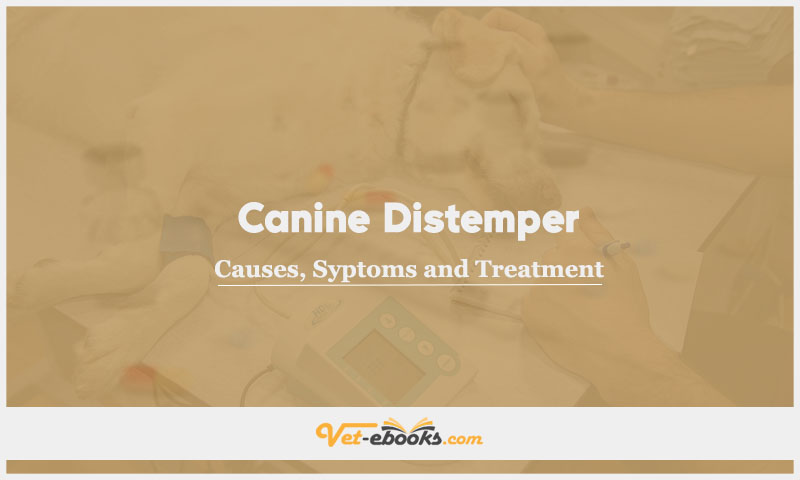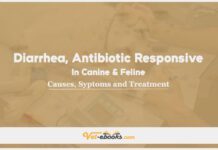Canine Distemper: Causes, Symptoms and Treatment

Overview
A viral infection in dogs that results in an acute to subacute febrile condition, leading to a fatal outcome and presenting with symptoms affecting the respiratory, gastrointestinal, and central nervous systems.
Causes of Babesiosis In Canine and Feline
Causes
- Caused by canine distemper virus (CDV), which belongs to the Morbillivirus within the Paramyxoviridae family.
- Affects numerous species within the Carnivora order, with the mortality rate exhibiting significant variation.
Risk factors
- Exposure of unvaccinated animals to CDV-infected animals, including dogs and wild carnivores.
Pathogenesis of Canine distemper
- The Morbillivirus, found in the Paramyxoviridae family, has an impact on various species within the Carnivora order.
- The mortality rate can vary significantly among these species.
- The natural mode of infection occurs through airborne and droplet exposure.
- Macrophages transport the virus from the nasal cavity, pharynx, and lungs to local lymph nodes, where virus replication takes place.
- Within one week following infection, virtually all lymphatic tissues become infected.
- The virus spreads through viremia to the surface epithelium of the respiratory, gastrointestinal, and urogenital tracts, as well as to the central nervous system (CNS).
- Initial symptoms may include fever lasting for 1–2 days and a reduction in lymphocyte counts, which could be the only observable signs during the initial phase.
- The progression of the disease depends on both the virus strain and the immune response.
- A robust cellular and humoral immune response may not manifest clinical symptoms.
- A weak immune response can lead to subacute infection, potentially extending the survival period.
- When the immune response fails, death typically occurs within 2–4 weeks after infection.
- Seizures and other central nervous system (CNS) disturbances are frequent causes of mortality.
- The infection affects various bodily tissues, including all lymphatic tissues, surface epithelium in the respiratory, digestive, and urogenital tracts, as well as endocrine and exocrine glands, and nervous tissues.
- In domestic dogs, the virus is typically limited to sporadic outbreaks.
- In wildlife, such as raccoons, skunks, and foxes, it is relatively common.
Symptoms (History & Physical Examination) of Canine distemper
History
- Most members of the carnivore families Canidae, Hyaenidae, Mustelidae, Procyonidae, and Viverridae are susceptible to the virus. Additionally, large cats in zoos and the wild from the felidae family can also be affected.
- Young animals tend to be more vulnerable to the virus compared to adults.
Physical examination
- Fever tends to manifest as intermittent spikes starting around 3 to 6 days following the initial infection.
- Gastrointestinal and/or respiratory symptoms can include nasal and ocular discharge, depression, loss of appetite, vomiting, and diarrhea. These symptoms are often exacerbated by secondary bacterial infections.
- Central nervous system (CNS) involvement is common but generally occurs after systemic disease, and its occurrence can be influenced by the virus strain. There are two distinct forms of CNS disease:
- Gray matter disease affects the cerebral cortex, brainstem, and spinal cord, potentially leading to non-suppurative meningitis, seizures, alterations in mentation, and ataxia. Some dogs may succumb within 2–3 weeks, while others recover, particularly those with a prompt immune response.
- White matter disease presents as multifocal symptoms, often involving cerebellovestibular issues, paresis, ataxia, and occasionally myoclonus. Some dogs may die around 4–5 weeks after the initial infection, displaying noninflammatory, demyelinating disease. However, some dogs may recover with minimal CNS damage.
- Other potential manifestations of the virus include optic neuritis and retinal lesions, with the possibility of anterior uveitis and keratoconjunctivitis sicca. Certain virus strains may lead to hardening of footpads (hyperkeratosis) and the nose, although this is uncommon.
- Additionally, neonatal infection with the virus can result in enamel hypoplasia of the teeth.
Diagnosis of Canine distemper
1- From History and Physical Examination
2- Diagnostic Procedures
- Detection of viral presence through immunohistochemical methods in areas such as the haired skin, nasal mucosa, and footpad epithelium.
- Identifying viral antigens or viral inclusions in various samples, including buffy coat cells, urine sediment, conjunctival or vaginal imprints, and trans-tracheal wash. It’s important to note that negative results may not conclusively rule out Canine Distemper Virus (CDV).
- Using reverse transcriptase polymerase chain reaction (RT-PCR) to test for the virus in samples like buffy coat, urine sediment cells, respiratory secretions, conjunctival swabs, and cerebrospinal fluid (CSF). False negatives are possible, and false positives can occur, albeit rarely, especially after recent vaccination.
- Examining cerebrospinal fluid (CSF) for signs of CDV infection, which may include moderate mononuclear pleocytosis, elevated levels of CDV-specific antibodies, interferon, and viral antigens during the early stages of the disease.
Pathological findings:
- Thymus: Reduced in size in young animals, sometimes appearing gelatinous.
- Lungs: Displaying patchy consolidation.
- Footpads and nose: Exhibiting hyperkeratosis (thickening of the skin).
- Various mucopurulent discharges, such as those from the eyes and nose, bronchopneumonia, catarrhal enteritis, and skin pustules due to secondary bacterial infections.
Histological observations:
- Intracytoplasmic eosinophilic inclusion bodies found in the epithelium of bronchi, stomach, urinary bladder, as well as in reticulum cells and leukocytes in lymphatic tissues.
- Inclusion bodies in glial cells and neurons, often intranuclear but also in the cytoplasm.
- Additional diagnostic methods include immunofluorescence and/or immunocytochemistry, virus isolation, and/or RT-PCR, performed on tissues from the lungs, stomach, urinary bladder, lymph nodes, and brain.
(CBC), Biochemistry, and Urinalysis:
- Lymphopenia is observed during the early stages of the infection, while thrombocytopenia is uncommon.
- Intracytoplasmic inclusions can be found in both white and red blood cells.
Other Laboratory Tests:
- Serological tests can produce positive results for antibodies, but they cannot distinguish between vaccination and exposure to the virulent virus.
- In some cases, patients may succumb to acute disease before neutralizing antibodies are generated. Immunoglobulin M (IgM) responses can be detected for up to three months after exposure to the virulent virus and up to three weeks after vaccination.
- Rising IgG titers in unvaccinated dogs may suggest infection and can be useful for assessing the risk of infection in clinically healthy dogs, particularly in shelter environments.
- The presence of CDV antibodies in cerebrospinal fluid (CSF) can indicate distemper encephalitis, but it’s important to note that false negatives are possible.
Imaging:
- Radiographs are used to assess pulmonary disease.
- CT and MRI scans may or may not reveal lesions; MRI is particularly sensitive in detecting demyelination.
3- Differential Diagnosis
- It is important to consider distemper as a potential cause in any young, unvaccinated dog displaying multifocal central nervous system (CNS) disease and other organ involvement.
- When evaluating such cases, it’s crucial to distinguish between distemper and other conditions:
- Kennel cough: Distemper can mimic the respiratory disease seen in young puppies.
- Enteric signs: These should be differentiated from infections like canine parvovirus (CPV) and canine coronavirus (CCV), as well as parasitic infections such as giardiasis, hookworms, and roundworms. Additionally, bacterial infections, gastroenteritis resulting from toxin ingestion, or inflammatory bowel disease (IBD) should be considered.
- CNS form: When dealing with the CNS form of distemper, it’s important to distinguish it from other conditions like granulomatous meningoencephalomyelitis, protozoal encephalitis (such as toxoplasmosis and neosporosis), cryptococcosis, or other infections like meningitis, ehrlichiosis, Rocky Mountain spotted fever (RMSF), pug dog encephalitis, and lead poisoning.
Treatment of Canine distemper
General
- Providing appropriate healthcare, ranging from inpatient medical management to intensive care as needed, along with the isolation of the patient to prevent transmission to other dogs.
- Administering intravenous (IV) fluids for hypovolemia and support.
- Utilizing oxygen therapy, nebulization, and coupage to manage pneumonia.
- Ensuring the cleanliness of ocular and nasal discharges.
- Limiting physical activity to reduce the potential for spreading the infection.
- The choice of diet depends on the extent of gastrointestinal involvement.
Medications:
- Antiviral medications have not shown effectiveness in treating the condition.
- The use of antibiotics is employed to reduce the risk of secondary bacterial infections because CDV profoundly suppresses the immune system.
- Beta-lactams or cephalosporins are good initial choices
- Anticonvulsant therapy, which includes medications like phenobarbital and potassium bromide, is utilized to manage myoclonus and seizures.
Some Notes:
- Corticosteroids should be avoided because they can enhance immunosuppression and potentially promote viral dissemination. In some cases, anti-inflammatory levels of corticosteroids may provide temporary symptom relief.
- High doses of tetracyclines may lead to renal tubular necrosis and can cause yellow discoloration of teeth in young animals.
- The use of fluoroquinolones in dogs up to 6 months of age may result in arthropathy and could potentiate seizures in epileptic animals.
- Vaccination with MLV-CD (Modified Live Virus Canine Distemper) effectively prevents infection and the development of the disease.
- There are two main types of MLV-CD vaccines available:
- Canine tissue culture–adapted vaccines (e.g., Rockborn strain) are capable of inducing complete immunity in nearly 100% of susceptible dogs. In rare instances, postvaccinal fatal encephalitis can occur, typically 7–14 days after vaccination, especially in immunosuppressed animals.
- Chick embryo–adapted vaccines (e.g., Onderstepoort, Lederle strain) are considered safer. They do not result in postvaccinal encephalitis, but they achieve seroconversion in only about 80% of susceptible dogs.
- It’s worth noting that Chick embryo–adapted vaccines can be safely administered to various zoo and wildlife species, such as gray foxes, whereas the Rockborn type can be fatal in these animals.
- Killed vaccines are recommended for species for which both types of MLV-CD vaccines can be fatal, like red pandas and black-footed ferrets.
- An alternative is the Canarypox recombinant CDV vaccine.
- Due to the decline in maternal antibody protection at 6–12 weeks of age in most puppies, it is advisable to administer 2–3 vaccinations during this period.
- Heterotypic vaccination with measles virus is recommended for puppies with maternal antibodies. This type of vaccination provides protection from disease but not from infection.
- Mortality rate is approximately 50%.
- Dogs that initially appear to recover from early catarrhal signs may still develop fatal central nervous system (CNS) disease.
- Neurological abnormalities, when present, are typically irreversible.
Tip
Do You Want To Increase Your Veterinary Knowledge and Practical Skills?
You Can Now Browse and Download +3000 Books For Veterinary Professionals & Students Online.
Download Veterinary Books
















